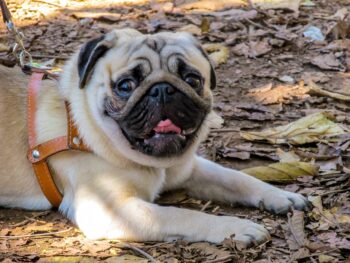Pugs, those adorable little clowns of the dog world, are known for their squishy faces, curly tails, and personalities as big as their eyes. These small dogs have been charming humans for centuries with their playful antics, love of snuggles, and a knack for making their owners laugh. Pugs are social butterflies, enjoying the company of humans and other pets alike, and they often have a talent for getting into mischief. However, even these spirited little dogs eventually reach their golden years. Typically, a Pug is considered a senior, around 8 to 10 years old, though some may start showing signs of aging a bit earlier or later. Pugs might slow down as they age, trading their zoomies for more naps, but they never lose their affectionate and comical nature. Let’s explore the different stages of a Pug’s life and see how these lovable dogs age with charm, humor, and a little extra snorting.
1. The Puppy Phase: Tiny Terrors with Big Eyes
They are tiny bundles of energy, mischief, and endless cuteness in the first year of a Pug’s life. Pug puppies are known for their playful and curious nature, often getting into all sorts of trouble with their boundless curiosity. They love to explore, chew on anything within reach, and have an uncanny ability to find joy in the smallest things. Training is crucial to teach them basic manners during this phase, although their adorably stubborn streak might make it a bit challenging. Pug puppies are also famous for their zoomies—sudden bursts of energy where they run around like little wind-up toys. Despite their antics, they are incredibly affectionate and love to snuggle up with their favorite humans.
2. The Adolescent Years: The Quirky Teenager
From around 1 to 2 years old, Pugs enter their adolescent phase. This stage can be a bit like the teenage years for humans—full of personality and sometimes a bit of attitude. Adolescent Pugs are still playful and energetic but might show a more independent streak. They enjoy testing boundaries and can be more stubborn than usual, making consistent training and positive reinforcement important. Despite the occasional stubbornness, Pugs at this age are still sweet and loving, and they continue to be great companions. They might also start showing more quirky behaviors, such as funny sleeping positions or a love for peculiar objects.
3. The Prime Years: Full of Life and Love
Between 2 and 6 years old, Pugs are in their prime. These years are marked by a balance of energy and maturity, making them delightful companions. Pugs in their prime are playful, loving, and full of life. They enjoy various activities, from playing with toys to lounging around the house. This is also when their affectionate nature shines the brightest—they love to be close to their humans, often following them from room to room. Despite their small size, Pugs have big personalities and are known for their expressive faces and endearing snorts. They are excellent at adapting to their owner’s lifestyle, whether an active or more relaxed household.
4. The Middle Ages: A Softer, Quieter Time
Pugs start entering middle age, around 6 to 8 years old. You might notice them becoming a bit more laid-back and less energetic. While they enjoy playtime and walks, they may prefer shorter, more leisurely activities. This stage is often marked by a greater appreciation for naps and a more relaxed attitude. Pugs might also show signs of aging, such as graying fur around the muzzle and a slower gait. Despite these changes, they remain affectionate and continue to enjoy being close to their humans. Pugs are known for their love of comfort, and middle-aged Pugs may seek out the coziest spots in the house for their naps.
5. The Senior Years: Wise and Wonderful
Pugs are generally considered seniors When they reach 8 to 10 years old. This phase is marked by a noticeable reduction in energy levels and a greater appreciation for the quieter things in life, like cozy naps and gentle cuddles. Senior Pugs may develop age-related health issues such as arthritis, respiratory problems, or eye conditions, affecting their mobility and overall well-being. However, their loving and comical nature often remains intact, and they continue to bring joy to their families. They may become more dependent on their human companions and cherish the time spent together. Despite their physical changes, senior Pugs often have a wise and calm demeanor, and their snuggles are as comforting as ever.
Pugs, with their unique looks and charming personalities, bring joy at every stage of life. From the playful puppy phase to the gentle senior years, these small dogs are full of love, humor, and a touch of mischief. While they may slow down as they age, their affectionate nature and playful spirit never fade. Each stage offers unique experiences and memories, making life with a Pug a delightful and heartwarming journey. Whether they’re making you laugh with their antics or cuddling up for a cozy nap, Pugs have a special way of brightening our lives. So, cherish every moment with your Pug, and enjoy the endless love and joy they bring into your life, from their squishy-faced puppy days to their golden years.
Frequently Asked Questions Someone Might Have About Their Aging Pug
The post When Does a Pug Reach Old Age? appeared first on iHeartDogs.com.

